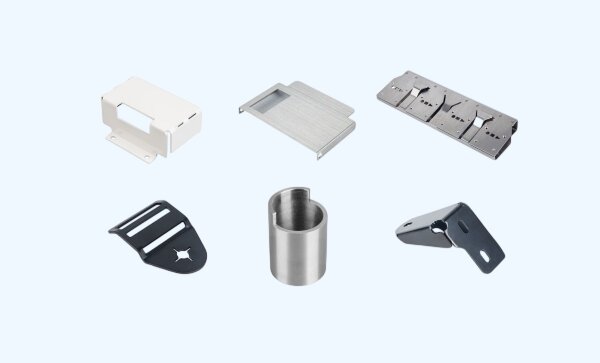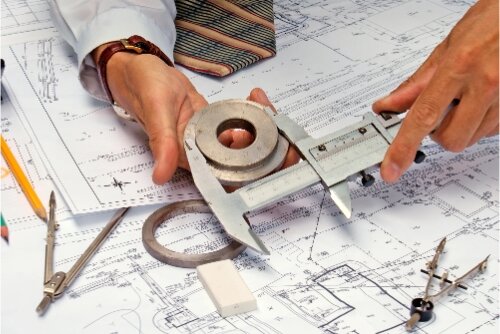When designing or sourcing metal parts, engineers and manufacturers often face a key question: which production method best suits the project in terms of cost and lead time? Selecting the wrong process can lead to wasted time, increased costs, and even component failure. Many assume that all metal parts are made in the same way, but in fact, different parts are best suited to other manufacturing processes.
That’s why it’s essential to understand the difference between sheet metal fabrication and sheet metal stamping. Each method has its own advantages, limitations, and ideal use cases. By understanding how they differ in terms of production speed, cost, precision, and material performance, engineers can make more informed decisions that save money, improve quality, and reduce lead times.
In the following sections, we’ll explain how each process works and where it performs best, helping you determine which manufacturing method fits your design, budget, and production goals.
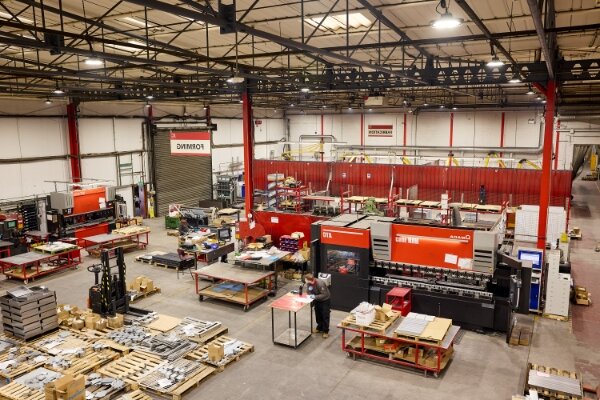
What Is Traditional Sheet Metal Fabrication?
Traditional sheet metal fabrication is a comprehensive manufacturing process that combines manual and machine operations to cut, bend, rivet, press-fit, countersink, emboss, weld, and assemble metal materials into finished parts. This method offers high flexibility, allowing engineers to quickly create prototypes and low-volume parts without the need for expensive molds. It also enables fast design changes at low cost.
Core Processes
Traditional sheet metal fabrication typically combines multiple forming and joining operations to transform flat metal sheets into functional components. Each step ensures dimensional accuracy, structural strength, and overall quality.
- Cutting: Laser cutting, shearing, waterjet cutting, or wire cutting is used to create flat shapes that match design dimensions, including internal holes.
- Bending: Using a press brake, the sheet is pressed between a die and a V-groove to form precise, smooth angles ranging from 0° to 180°.
- Welding: Techniques like MIG, TIG, or spot welding permanently join parts to create strong, seamless assemblies.
- Fastening and Hardware Insertion: Processes such as riveting, clinching, or installing PEM nuts, studs, and screws enhance part strength and simplify assembly.
- Finishing options, such as powder coating, brushing, anodizing, passivation, or painting, enhance appearance, improve corrosion resistance, and, in some cases, increase electrical conductivity.
- Assembly: Machined components are aligned, fitted, and secured to form complete assemblies ready for delivery or direct use.
Capabilities
Traditional sheet metal fabrication can handle a wide range of projects, from single prototypes to complete assemblies. It achieves tight tolerances, excellent surface finishes, and reliable structural integrity.
Typical products include enclosures, brackets, panels, cabinets, frames, and covers. Fabricators also make welded structures, racks, consoles, EMI/RF shields, and busbars used in industrial and electronic systems.
Many workshops offer in-house services, including finishing, hardware installation, and mechanical assembly. This shortens lead times and improves consistency across batches. Whether you require a complex prototype or a small production run, traditional sheet metal fabrication provides the flexibility and precision necessary to meet demanding requirements.
Typical Production Volume and Applications
Traditional sheet metal fabrication is most suitable for low to medium production runs. It offers short setup times for custom work and allows design modifications without major retooling.
This makes it ideal for industries that value flexibility and fast turnaround — such as electronics, medical devices, automotive prototyping, machinery components, server systems, battery packs, kitchenware, and metal furniture.
Manufacturers often use this method to produce custom enclosures, control panels, test fixtures, and precision housings. Since each project can be tailored to specific needs, traditional sheet metal fabrication is an excellent choice for engineers seeking customized, high-quality parts.
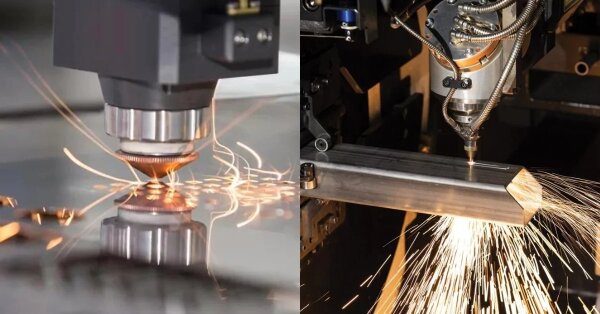
What Is Sheet Metal Stamping?
Sheet metal stamping is a process that uses specialized dies and high-speed presses to shape flat metal sheets into specific parts. Unlike traditional fabrication, which requires several manual steps, stamping can complete forming in one or several press strokes, making it fast and accurate. For parts with simple structures, stamping can often create the entire shape in a single operation.
Process Overview
The sheet metal stamping process typically begins by feeding flat sheets or coils into a stamping press. The press applies controlled pressure, pushing the metal into a die cavity to form the desired shape. Depending on the design, different stamping techniques may be used:
- Blanking: Cuts flat shapes from sheet metal before forming.
- Piercing: Punches holes or openings into the sheet.
- Bending: Forms angles or flanges in a single press stroke.
- Deep Drawing: Pulls the sheet into a die cavity to form hollow or curved parts.
- Coining: Applies high pressure to achieve precise dimensions, smooth surfaces, or acceptable flatness where needed.
- Embossing: Creates raised or recessed patterns to enhance strength or visual appeal.
These operations can be performed separately or integrated into progressive dies, which perform multiple steps in a continuous press cycle. This setup greatly increases speed, efficiency, and part consistency.
Tooling and Equipment
Sheet metal stamping depends on high-precision, durable tooling to achieve consistent, high-speed production. Each die is custom-made for a specific part and must meet exact design requirements. Typical equipment includes:
- Stamping Presses: Mechanical or hydraulic presses that provide the forming force. Different press tonnages are selected based on part thickness and size.
- Dies and Punches: Hardened steel tools that define the part’s shape, dimensions, and features.
- Feed Systems: Automated mechanisms that feed sheet or coil material into the press at a steady rate, improving efficiency, reducing manual labor, and minimizing worker fatigue.
- Die Maintenance Tools: Equipment used for cleaning, sharpening, and maintaining dies to ensure long-term accuracy and performance consistency.
Typical Materials and Thickness Range
Sheet metal stamping supports a wide range of materials, including cold-rolled steel, stainless steel, aluminum, brass, copper, and titanium. Each material offers different levels of strength, corrosion resistance, and formability, allowing engineers to choose the best match for the product’s performance requirements.
The typical processing thickness ranges from 0.2 mm to 6 mm, depending on material type and part design. Thin sheets are ideal for lightweight parts, while thicker sheets are used for load-bearing or high-strength components.
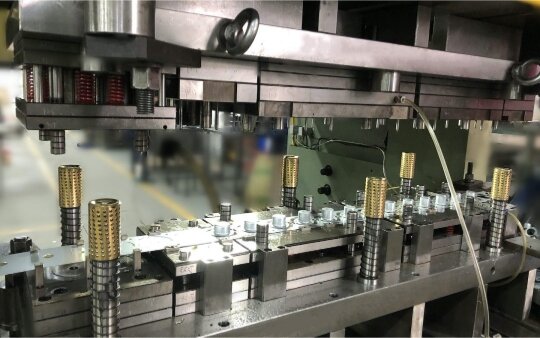
Significant Differences Between the Two Methods
Although both traditional sheet metal fabrication and sheet metal stamping produce metal parts, they differ significantly in production scale, cost structure, precision, and flexibility. Generally, fabrication emphasizes versatility and customization, while stamping focuses on high efficiency and mass production.
Production Efficiency
Traditional fabrication involves multiple steps, including cutting, bending, hardware insertion, welding, surface treatment, silk screening, laser engraving, and assembly. Each step requires individual setup and handling, making the process slower but highly flexible. It’s ideal for small- to medium-volume production or projects that require frequent design updates — changes can be made quickly and at a low cost.
In contrast, stamping relies on automated presses that complete multiple operations within a single cycle. Once the dies are prepared, parts can be produced at extremely high speeds with minimal manual input. This makes stamping the preferred choice for large-scale production, where speed, stability, and consistency are key.
Cost Factors
The most significant cost difference lies in tooling investment. Traditional fabrication does not require expensive molds, so its upfront setup cost is low, making it ideal for small batches or prototypes. The main expenses come from labor and machine time.
Stamping, however, requires precision-engineered dies, which involve higher upfront costs. But once the dies are ready, the price per piece drops dramatically. For high-volume or continuous production, the cost savings from mass output quickly offset the initial tooling investment.
Part Complexity
Traditional fabrication handles complex designs more easily and allows flexible modifications. Engineers can adjust features, mix materials, or change assembly methods without much disruption. This makes it ideal for prototype development, custom enclosures, and small-batch production.
Stamping, on the other hand, is more suitable for simpler, repeatable geometries. Once the dies are made, any design change requires retooling, which is both time-consuming and costly. However, stamping can still integrate multiple features — such as holes, bends, and embossments — into a single operation, maintaining high consistency across large volumes.
Precision and Tolerances
Traditional fabrication typically achieves tolerances between ±0.05 mm and ±0.20 mm, depending on equipment precision and operator skill. Tools like laser cutters and CNC press brakes enhance accuracy, but minor deviations may still occur due to manual welding or assembly processes.
Stamping offers higher and more consistent accuracy, often within ±0.05 mm or better, thanks to its fixed tooling and controlled press force. This level of precision is crucial for components that must fit precisely in automated assemblies or precision mechanical systems.
Part Strength and Structural Integrity
In traditional fabrication, parts are joined using welding, riveting, or fastening. These joints may introduce stress concentration points, but with proper process control and high-quality welding, the finished structures can still be strong and reliable.
Stamped parts, by contrast, are formed from a single sheet of metal, without weld seams or joint lines. The continuous metal grain improves overall strength and durability. In some cases, the forming process causes work hardening, which increases the material’s hardness, making stamped parts particularly suitable for high-load or high-stress applications.
Making the Strategic Choice for Your Project
Choosing the proper manufacturing method is one of the most crucial steps in ensuring the success of your project. Each process has unique strengths, and the key is to align the technique with your production goals, design requirements, and budget.
Evaluating Production Volume
Traditional sheet metal fabrication is most suitable for projects ranging from 1 to 1,000 units, where flexibility and design adaptability are more important than unit cost. Setup changes typically take only 1–3 hours and require no custom dies, making this approach ideal for prototypes, pilot runs, and specialized low-volume parts.
Sheet metal stamping, by contrast, becomes highly cost-effective once production exceeds 10,000 units. After the dies are completed, stamping presses can run continuously with minimal labor. A single high-speed press line can produce over 500,000 parts per month with excellent precision and repeatability.
For large-scale production, this high throughput quickly compensates for the upfront tooling investment.
Assessing Part Design Complexity
Traditional fabrication provides engineers with greater freedom in part geometry. It can handle complex assemblies involving multiple bends, welds, or subcomponents, and it allows frequent design changes. For instance, intricate enclosures or frames with ten or more bends and weld seams can be modified quickly without requiring changes to the tooling.
Stamping is best suited for parts that are simple, repeatable, and design-stable. Changing or reworking a die can take weeks and cost thousands of dollars, making it impractical for projects that require frequent updates. However, progressive stamping can still handle detailed parts with holes, ribs, and embossments — as long as the design remains fixed.
Considering Lead Time and Budget
Lead time and budget are also key factors in decision-making. Traditional fabrication can deliver prototypes within 3–7 days and complete low-volume batches in 2–4 weeks. The short setup time enables a swift transition from design to production.
Sheet metal stamping, however, requires a more extensive preparation period due to die design and manufacturing, which usually takes 4–8 weeks, depending on the part’s complexity. Once the dies are ready, production moves very fast — full-scale production can start within hours, and unit costs drop significantly.
From a cost perspective:
- Fabrication has a low startup cost but higher labor and machine costs per batch.
- Stamping involves a higher upfront tooling investment, but the per-unit cost is much lower for long-term or repeat production.
Ready to Start Your Project?
If you’re ready to bring your metal part design to life, now is the best time to act. Whether you need a high-precision prototype, custom low-volume production, or large-scale manufacturing, choosing the proper process can help you save time, reduce costs, and ensure excellent product quality.
Please send us your part drawings or 3D models as soon as possible. Our engineering team will review your design, provide professional recommendations, and offer a fast, no-obligation quotation.
Hey, I'm Kevin Lee

For the past 10 years, I’ve been immersed in various forms of sheet metal fabrication, sharing cool insights here from my experiences across diverse workshops.
Get in touch

Kevin Lee
I have over ten years of professional experience in sheet metal fabrication, specializing in laser cutting, bending, welding, and surface treatment techniques. As the Technical Director at Shengen, I am committed to solving complex manufacturing challenges and driving innovation and quality in each project.



